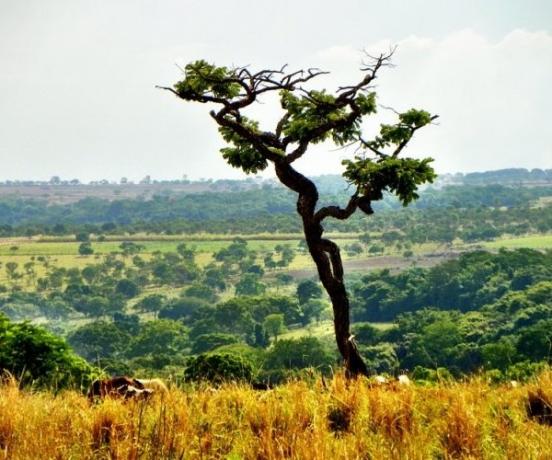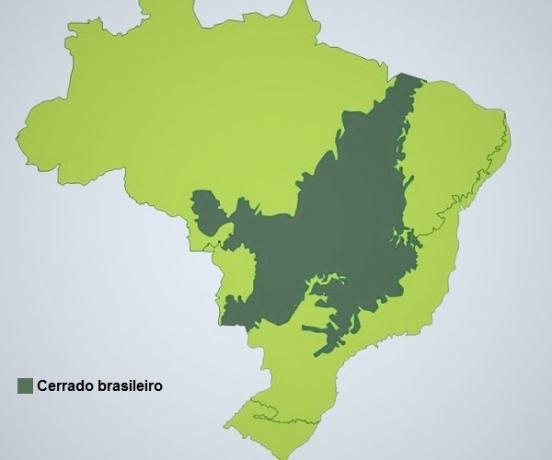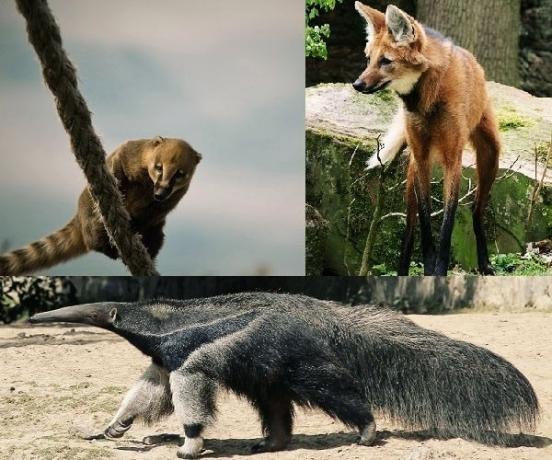The cerrado is a Brazilian biome located mainly in the Midwest region of the country. It is considered the second largest biome in South America, with more than 200 million hectares and occupies more than 20% of the territorial area of Brazil.
Biome is a type of ecosystem that has its own characteristics that make it different from others, such as the type of vegetation, fauna, climate and hydrographic occurrences (water).
Cerrado characteristics
The cerrado, although it spans several different states, has some characteristics in common everywhere. One of the main ones, which is very similar to the African savannas, is that the cerrado is a predominantly flat biome, with few undulations or elevated areas.
Another feature is that the seasons of the year, dry summer and wet and wet winter, are well defined.
The cerrado has another striking feature: a biodiversity. Whether in species of vegetation, trees, flowers or animals, the cerrado is one of the most diverse biomes in the world.
Cerrado vegetation and flora

The vegetation and flora of the cerrado are very diverse and vary according to the location of the area, as the cerrado covers several different states.
The vegetation, called grass, is creeping and formed by not very large shrubs of at most 20 meters in height, with thick bark and twisted trunks. In addition, the roots of trees and shrubs are quite deep, which makes it easier to search for water during periods of greater drought in the cerrado.
The flora of the cerrado is one of the most varied in the world, the biome has more than 11 thousand species of natural plants in the ecosystem. These are some of the species of plants and trees found in the cerrado:
- avocado,
- arrack,
- babassu,
- buriti,
- sugar cane,
- eucalyptus,
- Jatoba,
- macauba,
- kingwood,
- pequi tree.
The cerrado also has some species of edible fruits, such as cashew nuts from the cerrado, mangaba and barú seed.
Due to the long periods of drought and lack of rain during the summer, the soil of the cerrado is characterized by being dry and sandy. Furthermore, it is a soil with few nutrients and little water reserve, which makes it not very fertile for use in agriculture.
Extinction of Cerrado vegetation and flora
The vegetation and flora of the cerrado have already been greatly altered by the presence of human activity, mainly due to the use of the areas for agriculture and the creation of cattle herds. One of the worst consequences of this influence is the extinction of dozens of vegetation species that no longer exist in this ecosystem. About 20% of the original species of the cerrado flora no longer exist.
Less than 10% of the total cerrado area is protected as an environmental preservation area, which only increases the risk of extinction of species in the ecosystem.
Cerrado climate
The climate of the cerrado is classified as tropical seasonal, ie it is quite humid and hot. There are two seasons that are well defined, there are periods of prolonged drought and rainy periods. The average annual temperature is approximately 22 degrees and there is little occurrence of wind.
Summer is rainy, especially between the months of October and March, and has high temperatures, which can reach 40 degrees on the hottest days.
Winter is cold and dry, with little rain. The average annual rainfall is approximately 1500 millimeters and the temperature can reach 10 degrees on colder days.
Cerrado location
The Brazilian cerrado biome is extensive and covers the territories of several Brazilian states:
- Amapá
- Amazons
- Bahia
- Federal District
- Goiás
- Maranhão
- Mato Grosso
- Mato Grosso do Sul
- Minas Gerais
- Paraná
- Piauí
- Rondônia
- Roraima
- Sao Paulo
- Tocantins

Coverage area of the cerrado
The cerrado also encompasses other places due to the location of the hydrographic basins that belong to the ecosystem: the Prata Basin, the São Francisco Basin and the Tocantins Basin.
The Prata Basin is in the southern region of South America, the São Francisco Basin crosses the southeast, northeast and mid-west regions and the Tocantins Basin is in the central-north region of the country.
Cerrado fauna
The fauna of the cerrado is also very varied, being considered one of the greatest biodiversity in the world. More than 2500 species of animals in the biome have already been officially cataloged.
Among the most numerous species are birds, reptiles, fish and amphibians. In addition to these, there are also insects, butterflies and snakes in the cerrado.
Some species found in the fauna of the cerrado are:
- tapir,
- macaw,
- Bush dog,
- capybara,
- rattlesnake,
- Hart,
- shrimp,
- boa constrictor,
- Guara wolf,
- otter,
- capuchin monkey,
- guinea pig,
- Hedgehog,
- coati,
- Jaguar,
- anteater,
- Toucan.

Coati, maned wolf and anteater.
The cerrado has several species of animals that are at risk of becoming extinct. About 130 animals have already been observed at risk of extinction, such as the maned wolf, giant anteater and jaguar.
Meet 5 characteristics of the cerrado and also see the meanings of savanna, Biome, Caatinga, ecosystem, Biodiversity and Brazilian Biomes.
